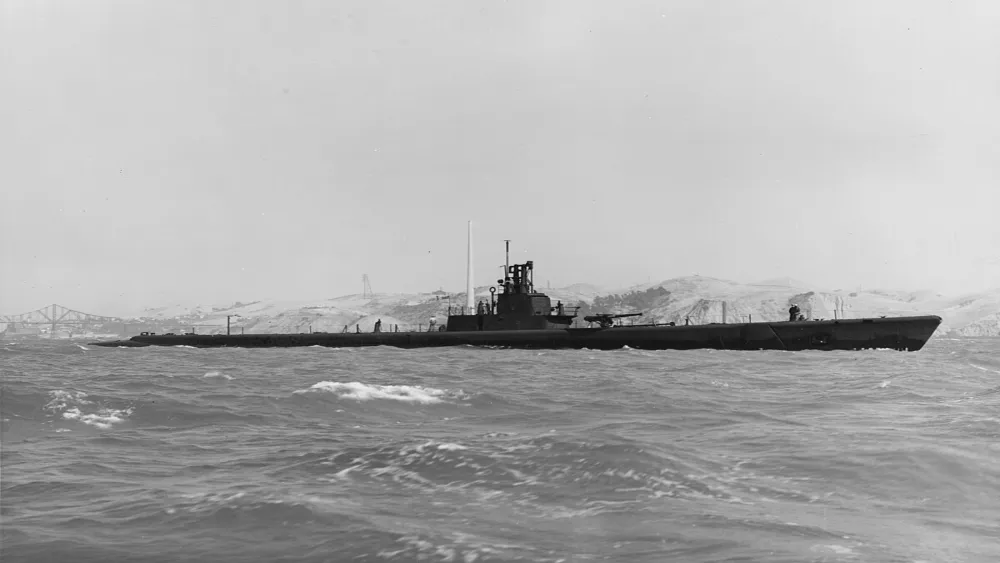The USS Wahoo (SS-238) was a Gato-class submarine, the first one in the U.S. Navy named after a fish called the Wahoo. It was built before the U.S. joined World War II and started its service afterward. The USS Wahoo operated in the Pacific during the war and gained a reputation for being a tough and successful submarine under the command of Lieutenant Commander Dudley Walker “Mush” Morton.
USS Wahoo: Formative Years
The USS Wahoo began its journey from the beginning, with its construction and launch marking significant milestones in its early history. The construction process kicked off at the Mare Island Navy Yard in Vallejo, California. The shipyard laid down the submarine’s keel on June 28, 1941. Notably, the launch event took place on February 14, 1942, and was sponsored by Mrs. William C. Barker, Jr. The USS Wahoo officially entered service on May 15, 1942, with Lieutenant Commander Marvin G. “Pinky” Kennedy, a member of the Class of 1929, assuming command. These early days also witnessed the emergence of many veteran stories, highlighting the dedication and skill of the submarine’s crew.
In these early days, Lieutenant Richard O’Kane served as the executive officer (XO) on the pre-commissioning crew. O’Kane continued to contribute to the submarine’s legacy by participating in five war patrols under the commands of both Kennedy and Morton. His exceptional service on the USS Tang would later earn him the prestigious Medal of Honor.
Setting Sail: August 12 – Departure from Mare Island
After completing its fitting out and initial training along the California coast, which included venturing as far south as San Diego, the USS Wahoo set sail from Mare Island on August 12. The submarine reached Pearl Harbor on August 18, where it engaged in exercise training until August 21, preparing for the challenges ahead in the Pacific theater of World War II.
On August 23, 1942, the USS Wahoo began its first war patrol. It targeted Japanese shipping west of Truk, specifically between the Hall Islands and the Namonuito Atoll. On September 6, during its third day in the area, Wahoo fired three torpedoes at a lone freighter. However, those shots were all missed. The freighter turned toward Wahoo, seemingly aiming to ram the submarine. Wahoo skillfully dodged, fearing a counterattack from the air.
USS Wahoo: Misses, Hits, and Underwater Explosions
Wahoo continued its patrol in the Truk area until September 20, then ventured south of the Namonuito Atoll. Under a bright moon, it spotted a freighter and escort. Wahoo fired three more torpedoes, all missing, but a fourth found its mark. The freighter listed and settled, and a series of underwater explosions followed. Despite being credited with sinking a 6,400-ton freighter, postwar analysis disputed this.
Wahoo encountered airplanes, a patrol boat, and a tender during its patrol but couldn’t engage them. On October 1, it extended its patrol to Ulul Island, sighting fishing boats. Missing opportunities, Wahoo couldn’t fire at the Chiyoda, a seaplane tender functioning as a mother ship to small submarines, or an aircraft carrier on October 5. Lacking aggressiveness, Wahoo departed the patrol area on October 7 and ended its first patrol at Pearl Harbor on October 17.
The next day, it began refit alongside submarine tender Sperry, then shifted to Submarine Base Pearl Harbor for overhaul. Installing a 4-inch gun and two 20-mm guns, Wahoo completed an overhaul on November 2, ready for sea after three days of training.
USS Wahoo: Second Patrol Impact
Beginning her second war patrol on November 8, 1942, the USS Wahoo, led by Lieutenant Commander Dudley, patrolled the Solomon Islands, keeping Bougainville and Buka Island in sight. On November 30, the submarine encountered a lightly loaded freighter with an escorting destroyer. Wahoo’s initial approach failed, leading her to proceed east of Cape Hanpan. After 17 days in the Buka-Kilinailau Channel, the submarine shifted to the direct route between Truk and the Shortland Islands on December 7. Wahoo’s encounter with a convoy on December 10 resulted in the sinking of the tanker Kamoi Maru, marking a successful engagement. Wahoo concluded her patrol in Brisbane, Australia, on December 26, with Morton replacing Kennedy as commanding officer on December 31, 1942.
Successful Escape: Departure from Danger
For Wahoo’s third war patrol in January-February 1943, Commander Dudley W. Morton, the commanding officer, delivered a memorable address to the crew, stating that Wahoo was expendable and offering those who wanted to stay behind in Brisbane a chance to do so. No one chose to stay behind. Ready for sea on January 16, 1943, Wahoo conducted sonar tests in Moreton Bay before starting the patrol. Lacking charts of the target harbor, the crew improvised with a school atlas. On January 24, Wahoo encountered the Japanese destroyer Harusame near Kairiru Island. Despite initial torpedo misses, Wahoo’s last bow torpedo struck Harusame amidships, causing significant damage, but the submarine managed to escape the area successfully. Despite repairs, Harusame was beached for further repairs.
USS Wahoo: Takes Down Kowa Maru on the Same Day
Beginning her fourth patrol on February 23, 1943, the USS Wahoo headed to Midway Island for refueling before reaching the Yellow Sea’s northern reaches, an unpatrolled area. Morton led the mission. On March 19, Wahoo sank the freighter Zogen Maru, followed by the Kowa Maru on the same day. Further successes included the sinking of the Hozen Maru and Nittsu Maru on March 21. On March 24, Wahoo encountered Takaosan Maru, a loaded tanker, which she sank after a series of torpedo misses. The patrol continued with additional victories until April 6, when Wahoo returned to Midway for refit, exceeding ship-sinking records.
Return to the Sea of Japan: Wahoo’s Ambitious Seventh Patrol
On her seventh patrol in September-October 1943, USS Wahoo aimed to return to the Sea of Japan. Carrying the newly arrived Mark 18 electric torpedoes, she left Pearl Harbor, refueled at Midway, and headed for La Perouse Strait. The plan was to enter the Sea of Japan by September 20. Unfortunately, Wahoo never reported back after October 21. She was credited with sinking ships, including Konron Maru, which provoked a Japanese ‘search and destroy’ operation. Wahoo was reported bombarded and sunk with all hands by Japanese forces on October 11. No U.S. submarines entered the Sea of Japan until June 1945. Wahoo earned six battle stars for her WWII service.

Legacy Lives On Honoring Bravery and Sacrifice
Unfortunately, Wahoo’s impressive run came to a tragic end in October 1943. While returning from a dangerous patrol in the Sea of Japan, the submarine was attacked and sunk by Japanese aircraft. This marked the end of an important chapter in naval history. Yet, the USS Wahoo’s legacy lives on. Therefore, it honored the bravery and sacrifice of the crew during a critical time in world events.
USS Wahoo’s Enduring Legacy: Lessons in Resilience and Sacrifice
The USS Wahoo’s legacy imparts vital lessons—meticulous planning and teamwork during construction, resilience, adaptability in hostile waters, and the unpredictable nature of war. Victories, missed opportunities, and the tragic end of the seventh patrol showcase the crew’s determination, sacrifice, and enduring impact on naval history.




